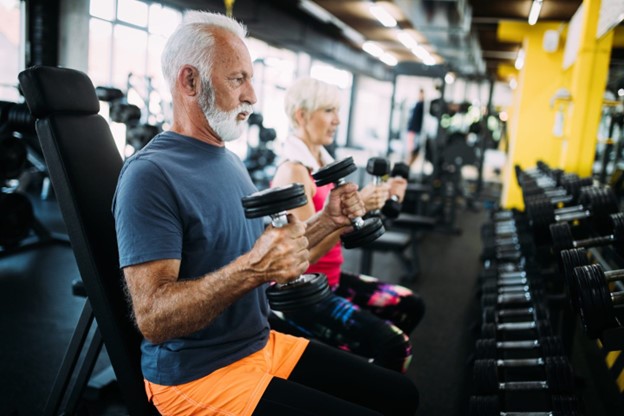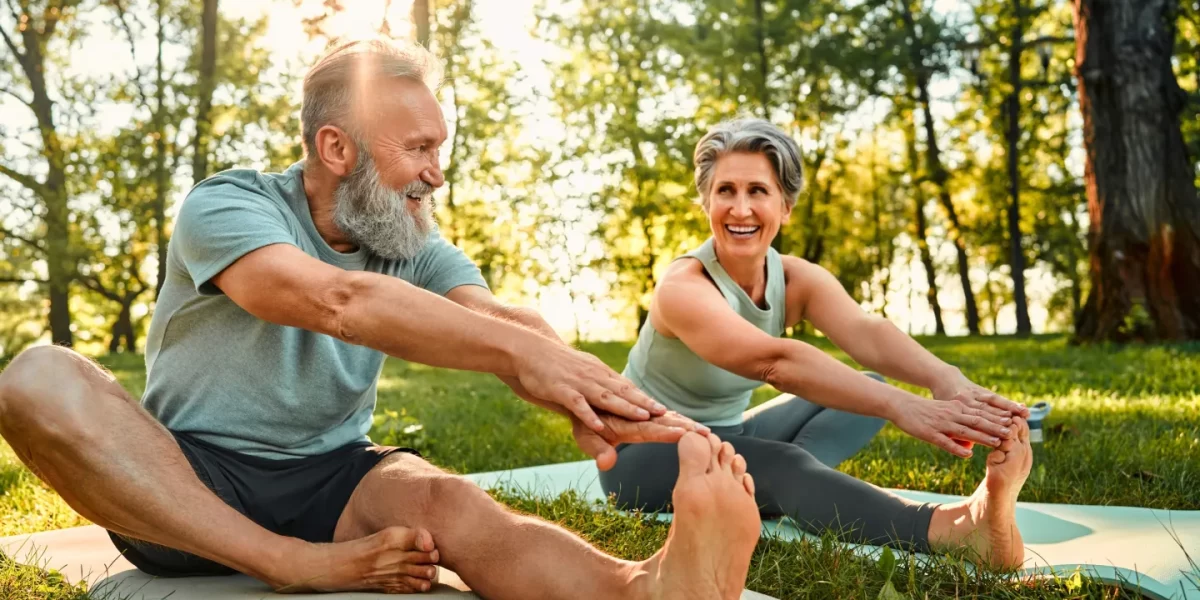
Staying fit should incorporate mental and emotional fitness as well.
Dr. Bill Dorfman, a 64-year-old cosmetic dentist in Southern California, prides himself on looking years younger, a characteristic he attributes to good genes and a daily workout regimen that helps staying fit
Three days a week he focuses on abs and cardio; the other days are for lifting light weights at high reps.
Dorfman says he got serious about exercise following a lull during dental school when he found himself frequently in pain. That’s when he realized his fitness had taken a back seat following years as a high school swimmer and gymnast. “What I found was the more I exercised, the better I felt,” he says.
Outside of the gym, he credits his daily Words With Friends habit with keeping his mind sharp. He also makes nightly dinner plans with various friends to stay connected.
Dorfman’s wellness habits underscore that one key to a longer life is a fitness regimen—but one that incorporates mental and emotional fitness as well.
“We really need to look at the life of an older adult with a holistic lens—if they’re really happy, healthy, and whole,” says Dor Skuler, cofounder and CEO of Intuition Robotics and an expert on loneliness in aging adults.
Here are four ways to focus on whole-body fitness as you age.
1. Exercise for the body and brain
Staying physically active and staying fit can prevent injuries and help the body heal faster when they happen, plus it’s also strongly linked to good mental health and brain function.
Kirk Erickson, PhD, director of Translational Neuroscience at AdventHealth Central Florida, where he studies the plasticity and modifiability of brain systems, has found physical activity to be one of the best ways to keep the brain healthy throughout its lifespan.
Erickson’s research shows that as we age, the brain shrinks, specifically the hippocampus, which is responsible for memory formation. Exercise can help maintain this portion of the brain and, in some cases, increase the size. There’s much to be learned about how and why this is, but Erickson says the effects are better the longer you engage in these habits, so it’s good to start young.
Of course you can still reap the benefits if you start later in life, he says. You might find that with time, you can recall memories and information more easily and have better executive function and a longer attention span when your brain is at its best, he says.
He recommends moderate exercise, like walking, five days a week for 30 minutes.
Aside from walking, Dr. Gary Small, chair of psychiatry at Hackensack Meridian Health, says strength training helps combat age-related muscle loss and can lead to a longer lifespan. Additionally, balance exercises can help prevent slips and falls—the leading cause of injuries in adults ages 65 and older.
Jasmine Marcus, a physical therapist at Cayuga Medical Center in Ithaca, N.Y., where she works with patients of all ages and physical activity levels, recommends tiptoeing into exercise if you’re new to it. She suggests starting with some kind of group fitness class like Zumba—anything that elevates your heart rate. It helps, too, if you have a partner to hold you accountable, she says.
2. Strive for mental fitness
Small also recommends doing activities that keep the brain in shape. One study showed the simple act of reading articles online and searching topics on Google offered valuable mental stimulation. Doing crossword puzzles, reading books, playing games, practicing hobbies, and daydreaming all contribute to mental sharpness and staying fit.
Stress management is also a critical part of maintaining mental fitness. Just 10 minutes of meditation a day can improve mood and cognitive agility, says Small, rewiring the brain and strengthening neural circuits.
“You don’t have to go to a retreat in Nepal or India to meditate, but you can learn the skills,” he says.
3. Stay social
The U.S. surgeon general issued an advisory last year warning of the nation’s loneliness epidemic, which negatively impacts health. One study equated lack of social connection to smoking up to 15 cigarettes a day. Other studies show social connection reduces the risk of premature death. It’s clear that social and emotional fitness is key to aging well and staying fit.
Skuler, whose company makes AI-powered social companions for aging adults aimed at keeping them active and engaged, says major life changes, such as the death of a spouse, often trigger loneliness.
“That is by far a watershed moment,” he says. Suddenly no one is asking how you slept or what you have planned for the day. A similar problem happens with asynchronous aging, where one spouse has a decline with dementia, for example. Other events such as retiring or sending the kids off to college might have similar impacts on social well-being, Skuler says.
ElliQ, the robot companion Skuler’s company makes, is one way to help aging adults stay connected, but he encourages all people to maintain friendships and relationships with family members. Volunteering, he says, can also add purpose and connection to your life.
4. Develop good sleep hygiene
There’s a myth that seniors need less sleep as they age, but Jamie Zeitzer, PhD, advisor and scientific reviewer at Rise Science, says the reality is sleep becomes more difficult with age. The result is that many seniors find themselves going to bed later and rising earlier.
“Humans are programmed to stay awake 16 [hours] and sleep eight hours,” he says. “An older person’s ability to do that diminishes, so they have to work a little harder at it.”
The causes for poor sleep can be both social and physical. We become more sensitive to sounds and temperatures as we age, says Zeitzer. So the garbage truck that never woke you on its weekly route might now rouse you at 6 a.m., he says. Similarly, a bedroom that’s too hot or cold might make it difficult to sleep.
As we age we also become more sensitive to caffeine. So if you used to be able to drink a cup of coffee in the evening, you could find you now have trouble falling asleep hours later.
There’s also a major shift that happens once we retire, when the social constraints around sleep are suddenly lifted. Seniors who don’t have social obligations early in the morning might find they’re less inclined to sleep at typical hours. A nap during the day, for example, may “cannibalize their sleep at night,” Zeitzer says.
Older adults might find that sleeping too little or having a fragmented night of sleep can lead to acute problems with cognition the following day, Zeitzer adds. Poor sleep over the long term is linked to health conditions including depression, Alzheimer’s disease, and cancer.
A good routine can solve some sleep problems. To start, avoid caffeine later in the day. And be mindful that you adjust the temperature in your sleep environment to encourage rest and staying fit..
And he recommends finding a way to wind down before bed. While some experts warn against the use of electronics before you grab some shut-eye, Zeitzer says watching a TV show can be helpful if it means you feel more relaxed and ready for bed afterward.
“It’s always good to aspire to closing your eyes and falling asleep, but other people need more kinds of wind-down routines,” he says.

If exercise is so healthy, why doesn’t Medicare always cover gym memberships?
A recent report published by the Centers for Disease Control and Prevention shows that many older Americans aren’t getting the recommended amount of physical activity.
According to the CDC, if you’re 65 or older, your weekly physical activity should include 150 minutes of moderate-intensity aerobic activity, two or more muscle-strengthening sessions, and balance-improving activities.
Physical activity is important at any age, and especially as we get older. Exercise helps the body heal more quickly and prevent injuries, and also supports mental health and brain function.
One way to make exercising easier is to join a gym, which typically offers most or all of the CDC’s recommended activities.
To become a member of a gym in the U.S., the average monthly cost is $58. That figure can vary widely, from $15 per month to some that cost several hundred dollars or more per month depending on the location and type of equipment, classes, and amenities.
In the U.S., 20% of gym members are 65 and older.
Does Medicare pay for your gym membership?
Medicare coverage of gym memberships would seem like a no-brainer, given the importance of physical activity for older adults, right? Nope.
“Original Medicare does not cover gym memberships,” says Jean Brasher, vice president and Medicare specialist at Brasher Brokerage in Delray Beach, Fla.
Why is that, when exercise offers so many benefits?
“Medicare cannot cover fitness, because it’s not related to medical problems,” says Diane Omdahl, author of Medicare for You and cofounder of the Medicare advisory firm 65 Incorporated.
Medicare coverage includes medically necessary services and a small range of preventive services to prevent sickness (such as vaccinations) or detect illness early when treatment is most likely to be helpful.
However, if you’re willing to sign up for a Medicare Supplement insurance plan, also known as Medigap, you may get gym membership and fitness coverage.
Medigap plans generally cost $200–$300 per month, depending on the plan and your location, says Brasher. That’s in addition to your monthly traditional plan, which is $174.70 per month for most people, with a $240 annual deductible. The main function of Medigap plans is to cover out-of-pocket expenses not covered by original Medicare (such as the 20% co-pay and deductibles), she says, and fitness coverage is an added benefit.
As of this writing, Brasher says one insurance carrier, United Healthcare, does offer Medicare Supplement plans that do include extensive coverage of gym memberships and fitness classes—varied by location but possibly including pilates classes, water aerobics, stretching sessions, and more.
Fitness options with this insurance carrier are available throughout the U.S., so if you travel or spend part of the year in another area, or want to check what’s available locally at zero cost, you can input your zip code.
Be aware that you may be limited in the number of monthly classes or the hours you can use certain facilities.
Medicare Advantage coverage of gym memberships
This is one area where Medicare Advantage private insurance plans—which can be lower in price than traditional plans, but often have limited doctor and hospital networks and require prior authorizations—clearly offer more benefits than traditional Medicare, at least in recent years.
“In 2019, CMS [Centers for Medicare and Medicaid Services] opened the door for Medicare Advantage plans to offer supplemental health-related benefits,” including benefits related to fitness, says Omdahl.
Today, according to data from Kaiser Family Foundation, 95% of Medicare Advantage plans offer fitness benefits.
The benefits vary widely, but often cover fitness classes and gym memberships, says Brasher, with many of these Medicare Advantage plans offering zero-cost monthly premiums.
Other fitness expenses covered by Medicare Advantage
Some Medicare Advantage plans have supplemental benefits that cover fitness expenses beyond gym memberships and classes.
For example, Brasher says, one insurance carrier offers a PPO plan which includes an $800 supplemental benefit. “You can buy an Apple Watch, skis, camping equipment—there’s a long list of what qualifies as a recreational benefit,” she explains.
Medicaid coverage of gym memberships
Fitness coverage is not a mandatory type of coverage under Medicaid, but states may offer it.
Free fitness options
Communities often provide free fitness resources to older residents.
Senior centers may offer free health and fitness classes—information on which may be provided by your local Area Agency on Aging.
A word of caution
While fitness is important, Omdahl recommends looking at the big picture when choosing a Medicare plan. “We always advise not to pick a Medicare plan for one of these supplemental benefits,” says Omdahl. “Plans can change, and your needs can change. You have to look at how the plan will work when you need medical care.”



Recent Comments